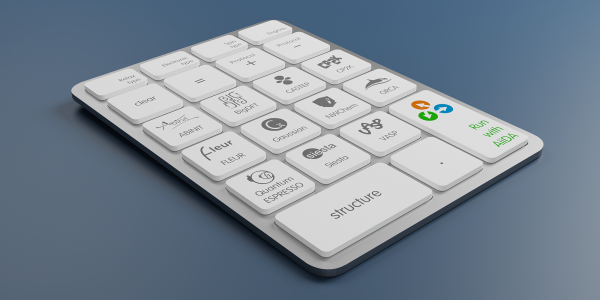Common workflows for computing material properties with various quantum engines
by Carey Sargent, EPFL, NCCR MARVEL
An increase in both available computational power and the number of appropriate quantum engines, or code, has led to the widespread use of density-functional theory (DFT) to compute system properties at the atomic level in both academia and industry. It remains, nevertheless, a complicated task.
Getting an accurate prediction requires in-depth knowledge of both DFT and the specific code used to perform the relevant calculations. While having access to a wide range of simulation packages can improve the accuracy and reliability of results through cross-verification, it’s difficult, even for specialists, to master more than a few of the various computational methods and interfaces. Software may then be chosen, for instance, because the researcher is familiar with it, not because it’s the best choice for the job at hand. Needing expert knowledge to correctly use DFT-based codes also limits its application and potential for encouraging scientific discovery.
While domain and code experts typically focus on implementing new functionalities and improving the accuracy of DFT calculations, they should also look to provide robust workflows with automatically selected numerical parameters and common interfaces that can be used by experts and non-experts alike. If designed to be reusable, they can become modular blocks to build more complex workflows. They must also be reproducible to guarantee that results can be validated.
The Atomistic Simulation Environment and its extension, Atomistic Simulation Recipes, have initiated efforts to provide a single interface for various codes. Still, challenges to developing a common workflow interface—particularly those focused on robustness, reusability and reproducibility requirements—still exist. In the paper “Common workflows for computing material properties using different quantum engines,” the researchers provide a solution based on AiiDA , an informatics infrastructure and workflow management system developed with major support by NCCR MARVEL, the EU MaX Centre of Excellence and numerous other supporting projects.

To demonstrate their approach, the scientists defined a common workflow interface specifically for the optimization of solid-state structures and molecular geometries, and implemented it for 11 different, very popular quantum codes. This workflow interface allows a user to optimize a structure using any of these codes without having to define code-specific parameters. Computed results are returned in a single unified format with identical units, making the results directly comparable and reusable, no matter which code was used to produce them.
“Each implementation of the workflow gives at least three protocols: ‘fast,’ ‘moderate,’ and ‘precise,’” said Emanuele Bosoni, a post-doc in the Institute of Materials Science of Barcelona (ICMAB) and in the MaX Centre of Excellence, and the second author of the paper. “They allow a user to specify the level of computational accuracy desired in an intuitive, general way. Based on the selected protocol, appropriate numerical parameters will be selected which have been carefully optimized by the workflow developer. In this way, the expert knowledge of the developer is directly encoded into the workflows, reducing the risk of incorrect or unreliable results and opening up the use of these codes to non-experts.”
According to Sebastiaan Huber, a researcher at EPFL and first author of the paper, the protocols that automate input selection make the workflows easy to use, but the interface nonetheless provides full flexibility, allowing users to override any of the predefined defaults.
“The realization of an interface that is both highly-automated while remaining fully flexible, is what makes these common workflows so usable and above all reusable,” he said. “Since AiiDA stores all parameters used in workflow steps, tracking the full provenance graph of executed workflows, the appropriateness of various inputs and the accuracy of the results can also be checked after the fact.”
To demonstrate the concept of modularity and the potential for cross-verification, the researchers used the common workflow interface to compute the equation of state (EOS) and the dissociation curve (DC), commonly computed properties for bulk compounds and diatomic molecules, respectively. Each property is computed by a single workflow using the common workflow interface as a modular building block, allowing for the use of any of the 11 quantum engines without the specification of any parameters unique to a given code. The EOSs and DCs computed by the various codes for a handful of compounds with different geometric, electronic and magnetic properties showed good agreement.
Despite this verification of results, the focus of this paper was rather to show how domain experts can provide robust and reusable workflows that automatically compute materials properties, allowing for the wider use of DFT-based quantum engines.
“We are already working toward a careful validation of the results on a much broader set of materials” said Giovanni Pizzi, senior researcher at EPFL and project leader in NCCR MARVEL, who coordinated the project. “At the same time, we also are extending the workflows to more codes, to more complex materials properties, and we plan to expose the workflows via simple graphical user interfaces (GUIs) in AiiDAlab, ultimately accelerating materials discovery and characterization.”
The implementations of the workflow interface of all quantum engines described in the paper are made available as free open-source software at https://github.com/aiidateam/aiida-common-workflows under the MIT license. To facilitate even more the use of these workflows by any researcher and make it straightforward to fully reproduce all the results presented in the paper, the data is openly shared on the Materials Cloud Archive. Moreover, all workflows, as well as the seven quantum engines with free open-source software licensing, come pre-installed in the Quantum Mobile virtual machine since v.21.05.1 (and the quantum engines with more restrictive licensing can still be manually installed on any computational resource and configured for use with AiiDA).
Reference:
Sebastiaan P. Huber, Emanuele Bosoni, Marnik Bercx et al., npj Comput. Mater. 7 , 136 (2021),
https://doi.org/10.1038/s41524-021-00594-6
Low-volume newsletters, targeted to the scientific and industrial communities.
Subscribe to our newsletter